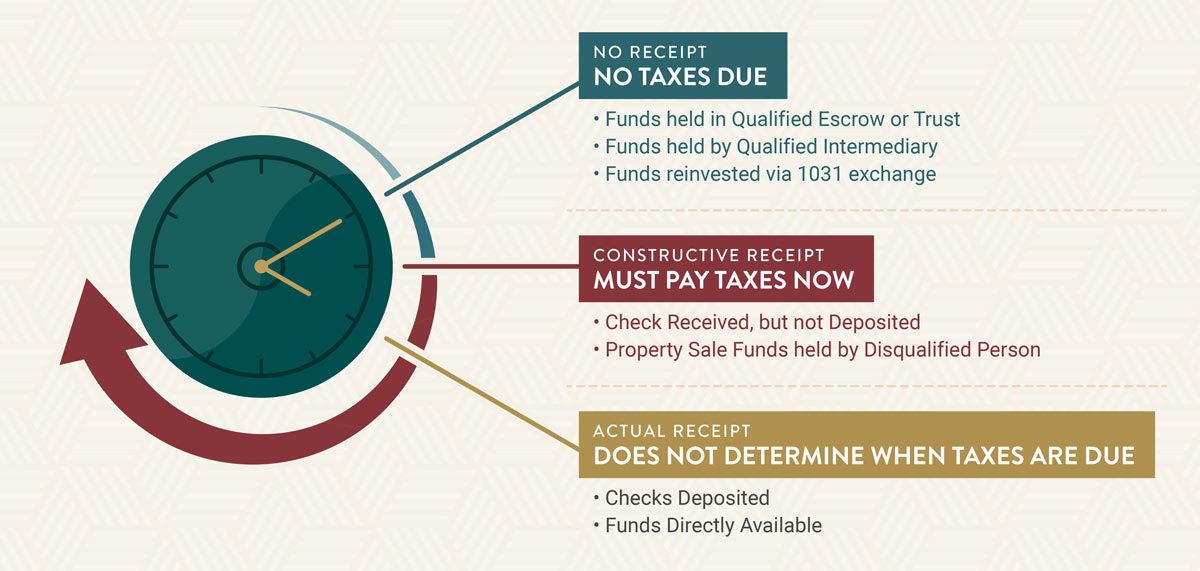Constructive Receipt: The Quick Run-Down
- In tax accounting, the constructive receipt date for income is the first date the funds are made available. Taxes are assessed based on the constructive receipt date even if the amount received is not cashed or deposited until later.
- Constructively received funds from the sale of an investment property are not eligible for the tax-deferral benefits of a 1031 exchange.
- To avoid constructive receipt in a 1031 Exchange, you can use one of the IRS-identified “safe harbors”. The most typical 1031 safe harbor is an independent third party facilitator, called a “Qualified Intermediary”.
What is Constructive Receipt of Income?
You are in “constructive receipt” of income when you have effectively received that income but do not hold the funds in your account. The term often serves to distinguish the date when a check is first made available from the date when the check is actually deposited.
One is in constructive receipt of a check payment on the earliest date that one could have deposited it. So, you can be in constructive receipt of a check today even if you will actually deposit it only sometime next week. Constructive receipt is the potential to access income, whether or not that potential is ever realized.
Those using cash-based accounting methods must pay taxes based on the date of constructive receipt, not the date of actual receipt. This distinction is especially important for year-end accounting and tax reporting. Payments can be constructively received in late December of one year, yet not deposited until January of the year following.
The term “constructive receipt” also applies when one receives income indirectly. Even if a payment was not made directly to you, you still can be in constructive receipt of the funds. If a friend, relative, or employee receives the payment on your behalf, you most probably are.
Constructive Receipt in a 1031 Safe Harbor Exchange
1031 exchange investors have special reason to learn about constructive receipt. Misapplying the concept can lead to a bungled exchange and so to hefty capital gains taxes.
To defer capital gain tax liability with a 1031 exchange, the seller must never be in constructive receipt of the proceeds from the sale.
If the IRS determines that an investor was in constructive receipt of any funds from the sale of a property at any time, that amount is taxable income. Such taxable gain is often called “boot”. Investors have to pay capital gains taxes on any and all boot. This is so even if an investor has purchased a replacement property with proceeds from the sale. So it is crucial to avoid constructive receipt as one attempts a 1031 exchange. (For the IRS’s definition of 'constructive receipt', see 26 CFR § 1.451-2(a).)
This "no constructive receipt" rule makes sense when we view the 1031 exchange as an exchange rather than just as some complicated kind of sale.
Consider the simple “simultaneous exchange”. With simultaneous exchanges, you don't have to fuss with money at all: you can just swap this for that. Since you don't receive any money in this scenario, it seems unjust for you to pay taxes as though you had. This is a guiding thought behind the tax deferral provisions of section 1031. You shouldn't have to pay taxes on money you never get!
Similar considerations bear on the more standard "delayed" 1031 exchange. Unlike the simple swap scenario, money does come into play in a delayed exchange. But if you set up that process so that at no point can you access those funds, you effectively don't "get" that money. (In this case, the money is held by a "safe harbor".) So, again, you shouldn't have to pay taxes on it.
The "no constructive receipt" rule clearly prohibits you from receiving the funds from the sale of your relinquished property. But it further prohibits your friends or family from receiving the funds on your behalf. If anyone with whom a seller has a pre-existing personal or financial relationship receives sale proceeds, the seller has the potential to access those funds. And that's all it takes to be in constructive receipt.
How Do You Avoid Constructive Receipt in a 1031 Safe Harbor Exchange?
Alright. So, to complete a full 1031 Exchange, you cannot be in constructive receipt of any proceeds from the sale of your relinquished property.
But if you can't receive the funds yourself, and you can't have someone you know hold the funds, how the heck can you avoid constructive receipt? We work through some answers below.
Avoiding Constructive Receipt with a Qualified Intermediary
The standard way to avoid constructive receipt in a 1031 exchange is by using an unrelated third party.
With this option, upon the sale of your relinquished property, you arrange for the funds received to be held by an intermediary party. This intermediary holds the proceeds until they can be reinvested into replacement property. Since the intermediary holds these funds just for the purpose of reinvestment, you are unable to access that money for personal use. That inability is how you avoid constructive receipt.
This third party is known as a “Qualified Intermediary” or an “Exchange Accommodator.” A Qualified Intermediary (abbreviated “QI”) can be a person or financial institution. In a typical 1031 exchange, you use a QI.
The thriving 1031 exchange industry has produced a wide array of QI professionals. Established QI professionals will know how to:
- Create an account for the sole purpose of facilitating your exchange
- Use that account to hold the proceeds from the sale of your relinquished property
- Help you identify potential replacement properties
- Use the sale proceeds to buy replacement property on your behalf
- Maintain appropriate records documenting each step of the process
QIs are one of four types of safe harbors defined by the IRS for avoiding constructive receipt during a 1031 exchange. For the details on 1031 safe harbors, see Section 1.1031(k)-1(g) of the Internal Revenue Code.
Read more to learn about what QIs do, who is eligible to be your QI, and what fees to expect in working with a QI.
Qualified Trusts and Escrow Accounts
Having 1031 funds collected and disbursed by a QI may alone be enough to meet IRS requirements. But implementing further restrictions adds an extra layer of protection from constructive receipt.
Income that might otherwise be subject to taxation may not be considered to have been constructively received if “substantial limitations or restrictions” are in place. Such limitations and restrictions are special measures to prevent you from accessing the funds:
Income is constructively received when an amount is credited to your account or made available to you without restriction. You do not need to have possession of it. If you authorize someone to be your agent and receive income for you, you are considered to have received it when your agent receives it. Income is not constructively received if your control of its receipt is subject to substantial restrictions or limitations.”
IRS Publication 538 (01/2019), Accounting Periods and Methods
Investors can direct their QI to hold exchange funds in a Qualified Escrow or Qualified Trust Account. These accounts place limits on how an Escrow Agent or Trustee may use the funds. Both limit fund access to transactions permissible under IRS regulation. An investor may not be the Escrow Agent or Trustee of a Qualified Account, nor may any other "disqualified person".
Can you Avoid Constructive Receipt of Income without a QI?
QIs and Qualified Accounts provide investors with multiple safe harbors for avoiding constructive receipt. But just as an investor may work with a QI without a Qualified Account, an investor may rely on a Qualified Account without working with a QI.
If an investor wishes to forego hiring a QI, it is important that the Qualified Account used have substantial limitations or restrictions placed upon it. Any use for purposes other than purchasing a replacement property must be prohibited. If the funds have even the potential to be accessed by the seller for any reason other than purchasing a replacement property, the IRS may deem the funds to be constructively received.
For example, in Crandall vs. Commissioner of Internal Revenue, investors sold a property and put the proceeds into a trust account for the purpose of completing a 1031 exchange. This trust account was intended to be a Qualified Trust Account under the IRS’s safe harbor. But the investors themselves were listed as the trustees on the account. Further, no substantial limitations or restrictions were placed on the use of the funds. The investors could have withdrawn or disbursed the funds for anything.
As a result, the IRS considered the funds to be readily available to the investors and thereby constructively received. Though it was clear what the investors intended to achieve, their intent, alone, was insufficient to meet tax deferral requirements. As explained by the Commission in its published ruling:
“We have no doubt that petitioners intended the transaction to qualify under the provisions of section 1031. However, it is well established that a taxpayer's intention to take advantage of tax laws does not determine the tax consequences of his transactions.”
Crandall v. Commissioner of Internal Revenue, TC Summary Opinion 2011-14
Despite their best intentions, because the investors did not implement sufficient restrictions on their own trust account, they had to pay taxes on 100% of the capital gains from the sale of the relinquished property.
Transaction-Related Expenses
Although an investor may not take constructive receipt of the funds from a relinquished property without incurring tax liability, select real estate transactional expenses related to the purchase of a replacement property may be covered with exchange funds.
Earnest Money
Earnest money is a down payment in a real estate transaction. If earnest money is collected during the sale of a relinquished property, it must be held in escrow and then transferred directly to a Qualified Intermediary in order to avoid capital gains taxes. This money may be used as a down payment on a replacement property, so long as the QI directly issues the funds to the seller of the replacement property.
“Normal Transactional Costs”
The IRS allows an investor to use exchange funds to cover normal transactional costs related to closing on a replacement property. There is no single list of permissible transactional costs provided by the IRS. But, according to the American Bar Association’s Guidance on 1031 Exchanges:
“Deductible costs of sale are items which would be deductible if the transfer were a sale and not an exchange such as:
- Broker’s commissions
- Escrow and title fees
- Attorneys’ fees
- Accommodators’ fees
- Fix-up expenses which would be deductible if sold.”
Investors should seek the guidance of a tax professional to determine which costs may be covered with exchange funds.
Avoiding Constructive Receipt when Withdrawing Excess Funds
An investor can identify multiple replacement properties to complete a 1031 exchange. Depending on which identification rule a 1031 investor uses, they may identify more properties than they ultimately purchase.
When you identify more replacement properties than you acquire, this can leave an excess amount in the exchange account. While this excess may be returned to an investor, it is important that the funds remain in the account until the 180-day exchange period expires. If excess exchange funds can be readily withdrawn from the account for reasons other than purchasing a replacement property, the IRS may consider that the funds already invested in a replacement property could have been similarly withdrawn. And if that is so, the entire amount placed in the exchange account (or ALL of the proceeds from the sale of the relinquished property) will have been constructively received and ineligible for tax deferral.


